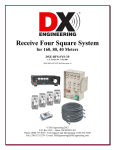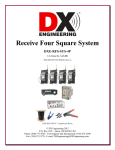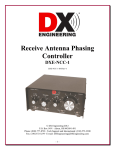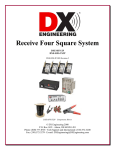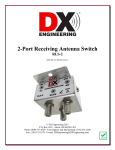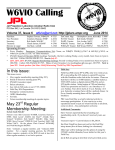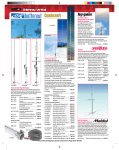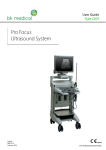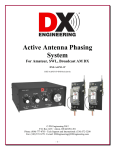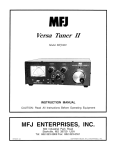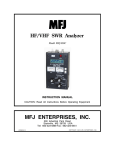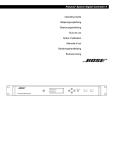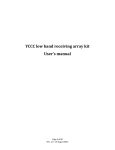Download instructions - DX Engineering
Transcript
Receive Eight Circle Array Complete System Package DXE-RCA8B-SYS-4P U.S. Patent No. 7,423,588 DXE-RCA8B-SYS-4P-INS Revision 2a © DX Engineering 2012 P.O. Box 1491 ∙ Akron, OH 44309-1491 Phone: (800) 777-0703 ∙ Tech Support and International: (330) 572-3200 Fax: (330) 572-3279 ∙ E-mail: [email protected] Table of Contents Introduction Are you ready to build your Receive Eight Circle Array? DXE-RCA8B-SYS-4P Complete System Package Additional Parts Required, Not Supplied with the DXE-RCA8B-SYS-4P Eight Circle Layout System Overview Installation Control and Power Connections Receive Eight Circle Active Vertical Elements Ground System Lightning Protection Array Spacing Station Feedline, Active Element Feedline and Delay Line Vertical Element Feedlines Typical DXE-RCA8B-SYS-4P Receive Eight Circle Configuration Delay Line Optimizing the Array Theory of Operation of the Receive Eight Circle Array System Design Features and Benefits Frequency Coverage -vs.- Element Type Receive Antennas - Gain and Efficiency Site Selection Effects on Patterns Site Selection in Relation to Noise Sources Proximity to Transmitting Antennas Examples of Array Performance Multi-Band Arrays with Active Elements Delay Line Topographical Considerations Sizing the Array Optional Items Technical Support and Warranty 3 3 4 4 4 5 6 6 8 9 9 10 10 11 12 13 13 14 14 15 16 16 17 17 18 19 20 21 23 24 26 28 -2- Introduction Congratulations on your purchase of the DX Engineering Receive Eight Circle Array System designed by W8JI, which offers the best directional receiving performance in proportion to the space required. Advanced design, with a stable, clean, narrow and low-angle pattern in eight selectable directions, makes the DX Engineering Eight Circle Array the ultimate receiving antenna. The Eight Circle Array System is an eight element, eight direction-switchable array based on a four element end-fire/broadside combination of short receiving vertical elements. This antenna array is capable of delivering pattern directional performance superior to standard or short Beverage or reversible Beverage systems, and typical three element or four square arrays of short vertical elements. The DX Engineering Receive Eight Circle Array System offers selectable directional performance comparable to eight very long phased Beverages, and does it in far less space. Advantages of this DX Engineering Receive Eight Circle Antenna System over other arrays: W8JI design with stable, narrow and low-angle pattern Directional performance varies with circle radius Included Active Receive Verticals with 8.5 foot elements cover a single band or multiple bands within 500 kHz to 30 MHz Excellent directivity in a smaller space than phased Beverages for better signal-to-noise ratio Reduced susceptibility to high angle signals compared to phased Beverage antennas, as well as superior performance over EWE, Flag, Pennant, K9AY antennas. Switching console selects one of eight 45° spaced directions Directivity over a very wide frequency range Less physical space and less maintenance required than phased Beverage antenna arrays Enhanced relay contact reliability DC powered control console allows system operation without AC power mains The DXE-RCA8B-SYS-4P is a complete Receive Eight Circle Antenna Array Package which may be installed as a Mono-Band or Multi-Band system using a recommended or alternative array radius for the frequency coverage desired. A single delay line can be made to accommodate the desired band or bands of operation according to the information provided in the Delay Line section of this manual. Are you ready to build your Receive Eight Circle Array? We are pleased that you have purchased a Complete Receive Eight Circle Array System Package model DXE-RCA8B-SYS-4P because you wanted the ultimate receive antenna system complete with Active Vertical Antenna including mounting hardware and rolls of coaxial cable with connectors and tools; virtually everything required to install a complete system. Before you proceed with installation, there are some fundamental concepts that you should know. 1. Have you sized your array to achieve the desired performance within your space? Do you know where you will be locating your Receive Eight Circle Array? Review the explanation -3- of the optimal monoband and multi-band frequency coverage of the Eight Circle Array in sections entitled Array Performance, Site Selection and Sizing the Array. 2. Do you prefer a system that provides the benefits of the DX Engineering Active Matching Units but allows you to experiment with your own tubing or whip elements? You may want to review the manual for the DXE-RCA8B-SYS-3P. 3. Are you ready to build your system? Proceed! The DXE-RCA8B-SYS-4P Receive Eight Circle Array Packages includes: DXE-RCA8B-1 Receive Eight Circle Array Controller DXE-CC-8A Special eight position Receive Eight Circle Control Console modified to provide +12 Vdc for powering the active antennas. DXE-SSVC-2P Stainless Steel V-Clamp for mounting the RCA8B1 Receive Eight Circle Array Controller to a mounting post between 1" and 2" OD DXE-ARAV3-8P (Eight) Active Matching units with Internal Disconnect Relays, 102" Stainless Steel Vertical Whips, Insulated Mounting System and Stainless Steel V-Clamps to be used with customer supplied ground rods for mounting DXE-F6-1000 (Two) 1000 Foot Rolls, Coaxial Cable, 75Ω, F6 Flooded Cable DXE-CPT-659 Coaxial Cable Prep Tool for RG6, F6 75Ω Coaxial Cable, w/extra blade DXE-SNS-CT1 Snap-N-Seal® Compression Tool for 75Ω coaxial cable connectors DXE-SNS6-25 Package of 25 Snap-N-Seal® Connectors for 75Ω F6 coaxial cable Additional Parts Required, Not Supplied with the DXE-RCA8B-SYS-4P One additional DXE-F6-1000 75Ω Coaxial Cable that may be required for the main feedline from the station to the array Five-Conductor Power and Control Cable. The modified DXE-CC-8A Control Console interfaces to the DXE-RCA8B-1 Eight Circle Array Controller through a 5-wire cable to select one of eight directions and to power the eight active elements. Economically priced DXE-CW9S is a 9-conductor control wire which may be used allowing the user to use the spare wires to double up on power and return lines for current carrying capability. Eight Circle Layout The optimized array for single band performance has vertical elements arranged in a circle with a radius of about 175 feet for 160 meters, or 84 feet for 80 meters, or 44 feet for 40 meters. A two-band array for 80 and 160 meters should also have a radius of about 84 feet. See the Theory of Operation sections for exact dimensions, options for wider frequency coverage and guidance in choosing the best orientation. The default direction of the array with no voltage (BCD 000) places elements 1 and 6 in front and elements 2 and 5 at the rear, with pairs of lines through two opposite vertical element pairs (tangents) that point -4- toward the receiving directions. Elements 1, 2 and 5, 6 are selected as the default for a forward direction of North-East for North America, with elements installed as shown. A mirror image of this element positioning would be a typical default North-West for European installations. Figure 1 - Typical Diagram of the DXE-RCA8B-SYS-3P Receive Eight Circle Array System System Overview The heart of the DXE-RCA8B-SYS-4P system is comprised of the modified DXE-CC-8A Eight Position Control Console, the DXE-RCA8B-1 Receive Eight Circle Array Controller, eight DXEAVA-2 Active Matching Units for your vertical elements and one Delay Cable with F-Connectors installed. These units interconnect and work together using factory default settings to control the Receive Eight Circle Array. The modified CC-8A control console uses BCD switching voltages for the RCA8B-1 to change the receiving direction of the array. When the modified CC-8A Eight Circle Control Console and the RCA8B-1 Receive Eight Circle Array Controller are connected as shown in the installation section below and the layout is as described for North America in Figure 1, the switch positions on the modified CC-8A will switch the array in the eight directions as shown in Figure 2. Figure 2 -5- Installation The RCA8B-1 Receive Eight Circle Array Controller can be mounted to a customer supplied galvanized steel pipe driven into the ground at the center of the array. A galvanized pipe ranging from 1 to 2 inch OD may be used. The length of the controller unit's mounting pipe is dependant on your location. The standard 1-1/2" galvanized water pipe (with its approximate 1.9" OD) is just fine for this application and can usually be found at your local home building supply store. The RCA8B-1 relay unit has been pre-drilled to accommodate up to a 2 inch OD pipe using the included DXE-SSVC-2P Stainless Steel V-Bolt Saddle Clamp for 1" to 2" OD pipe. An optional DXE-CAVS-1P V-Bolt Saddle clamp can be used for pipe from 3/4" to 1-3/4" inches OD. The controller can also be mounted on a sturdy wooden post if provision for grounding the RCA8B-1 unit has been made. Note: UMI-81343 Never-Seez or DXE-NSBT8 Anti-Seize should be used on all clamps, bolts and stainless steel threaded hardware to prevent galling and to ensure proper tightening. The Receive Eight Circle Array Controller unit should be mounted as shown in Figure 3 with cover upward and the control and coaxial cable connections downward to prevent water from entering the box. The stainless steel base of the Receive Eight Circle Array Controller unit has weep holes to allow condensation that may build up inside the unit to leave. Figure 3 - RCA8B-1 unit mounted to 2" pipe using the included DXE-SSVC-2P V-Clamp Control and Power Connections 1. Locate the removable green connector on the rear of the modified CC-8A labeled "G A B C D”. The green connector is a two part connector as shown and the top part can be removed by pulling it straight off. This will allow easier wire replacement or servicing as needed. When pushing the removable connector back in place, ensure you press straight inward to fully seat the connection. 2. Insert the five wire cable on the green connector as shown in Figure 4. 3. The same five wires are connected to the RCA8B-1 removable green connector (G A B C D) as shown in Figure 5. (“D” is required only for voltage on the element feedlines and should not be connected for passive vertical arrays.) 4. The modified CC-8A Control Console requires a nominal +12 Vdc fused input (+12 to +14 Vdc, 2 Amps and well filtered) through the 2.1 mm connector on the rear of the unit. -6- A 2.1 mm power cord is supplied with unit. The wire with the white stripes is the +12 Vdc. Outer Connection is GROUND Center Pin is +12 VDC. Figure 4 - Connections between the RCA8B-1 and the modified CC-8A The RCA8B-1 uses a removable five terminal plug as shown in Figure 5. The RCA8B-1 connections are labeled “G A B C D”. The terminals use the same connection letters and are connected G to G, A to A, B to B, C to C and D to D. On the RCA8B-1 the green connector is a two part connector as shown in Figure 5 and the top part can be removed by pulling it straight off. This will allow easier wire replacement or servicing as needed. When pushing the removable connector back in place, ensure you press straight inward to fully seat the connection. Figure 5 - RCA8B-1 Green Connector -7- Switch Position 1 2 3 4 5 6 7 8 G GND GND GND GND GND GND GND GND A 0 1 0 1 0 1 0 1 B 0 0 1 1 0 0 1 1 C 0 0 0 0 1 1 1 1 D 1 1 1 1 1 1 1 1 Table 1 - Modified CC-8A Output Truth Table Control lines (usually BCD ) can normally use good quality CAT5e cable (4 twisted pairs of 24 AWG wire) for runs up to 1000 feet. Typical DX Engineering BCD control lines requirements are +12 VDC at 25 milliamps. Depending on the number of control lines needed (usually 3 or 4) you can double up the twisted pairs of CAT5e cable, or use control wire that is at least 22 AWG, allowing runs up to 1500 feet. If you use a cable with more conductors, it is a good idea to tie the unused conductors to ground. For longer runs of control cable, use a line loss calculator to ensure you supply the proper control levels needed. Approximate BCD Control Line Lengths. Minimum Copper Wire Gage (AWG) 24 22 20 Length 1,000 feet 1,500 feet 2,000 feet Active antenna circuitry needs a good voltage supply to operate properly. When supplying power to an active antenna, you want to have +12 VDC, 60 milliamps at each active (under load). CAT5e cable is not recommended when making long runs to power an active antenna since the line loss in CAT5e cable may not supply the proper operational voltages required for active antennas. Depending on the required length of your power wire, you will want to use a line loss calculator (voltage drop with various wire gages) to ensure your power supply (normally +13.6 well filtered DC) will supply a minimum of +12 VDC, 60 milliamps at each active antenna (under load). A DX Engineering 4 Square or 8 Circle will require approximately 250 milliamps (only 4 actives are powered at any one time). When calculating line length, take into consideration the total number of active antennas being powered at any one time in your line length calculations. Approximate Active Antenna Power Line Lengths (4 active antennas on at any one time). -8- Minimum Copper Wire Gage (AWG) 18 16 12 10 Length 300 Feet 500 feet 1,200 feet 2,000 feet Receive Eight Circle Active Vertical Elements The DXE-RCA8B-SYS-4P Eight Circle Array is supplied with DX Engineering model DXEARAV3-8P Active Receive Verticals package, which consists of eight identical ARAV3-1 Active Receive Vertical Antennas. Featuring the AVA-2 Active Matching Units, the ARAV3-1 offers excellent broadband receiving performance from 100 kHz to 30 MHz. In addition, the ARAV3-1 provides a clean, low profile installation using whip antenna elements only 102 in. long. DX Engineering’s unique design makes it vastly superior to other amplified and traditional active antennas in both strong signal handling and feedline decoupling. You get significantly better weak signal reception due to lower spurious signal interference and reduced noise. The ARAV3-1 Active Receive vertical matching units ground the antenna element when power is turned off. The active antennas allow installations with spacing from transmit antennas less than 1/2 wavelength but more than 1/10 wavelength (on the lowest frequency). Close spacing of the array to transmitting antennas can be done, but will impact overall receive array system performance. Sites without sufficient land area for proper spacing should use these verticals, which may be installed in close proximity to transmitting antennas (1/10-wavelength of the lowest transmitting frequency). This is possible, provided the active units are powered off at least 5 ms before transmitting. An optional sequencer such as the DXE-TVSU-1A should be used to ensure the correct transmit to receive switching Your eight identical DXE-ARAV3-1 Active Vertical Antennas must be mounted so they are selfsupporting and insulated from the mount. A ground rod may be used as the ground mount. The vertical element must be connected only to the positive terminal of the DXE-AVA-2 Active Matching Units, and the negative terminal must be connected to at least one ground rod. Two ground rods may be needed in some soils. The Active Receive Verticals normally do not need ground radials, however, depending upon the conductivity of the soil, in sandy soil or rocky soil installations, wire radials may be required. The Active Receive Verticals should be installed with their feed points as close to the ground as possible but above any standing water. The level of snow cover over the feedpoint and the active vertical is not an issue. If you are planning to use the array on the 160 meter band, a jumper in the active antenna matching units may be changed to limit the Active Matching Unit response to the AM Broadcast Band. Placing a jumper on L1MF will peak the array sensitivity response for use on 160 meter, with little effect on 80 meters. For access to the jumpers in the Active Matching Units, remove the 2 screws on each side of the case and remove the bottom. The circuit board and jumper headers will be visible, as shown in Figure 6. By default, there are no jumpers across any pins. Place a jumper across L1MF. Normally, jumpering any other positions will not be required for most -9- operations. Typically, the goal of reducing the array sensitivity within the AM Broadcast Band is the only reason for adjusting the jumpers in the Active units. If maximum AM Broadcast Band reception is desired, or if the array is very far from strong AM Broadcast signals, then no jumpers should be used. All eight active elements in the array must have identical jumper settings. Figure 6 - Active Element L1MF Jumper Locations See the DX Engineering Active Receive Vertical Antenna user manual for more information about additional peak response jumper settings. Ground System The ARAV Active Elements work well with just a single copper ground rod placed as close as possible to the mounting pipe. The mounting pipe can be used as the system ground if the pipe is an adequate ground. It is recommended that a 3/4" or larger rigid copper water pipe, although conventional copper coated steel rods may also work. Depending on soil conductivity, you can expect better performance with multiple ground rods spaced a few feet apart. Increasing ground rod depth beyond 5 ft rarely improves RF grounding because skin effect in the soil prevents current from flowing deep in the soil. Avoid ground rods less than 5/8" OD. A good ground system improves the array performance and enhances lightning survivability. It is important that the ground system is identical for each active antenna in the array. You can test ground quality by listening to a steady local signal. Attach 15 ft of wire laid in a straight line (away from the coaxial feedline) to the initial 4 ft to 6 ft ground rod. If you observe a change in signal or noise level, you need to improve the ground. A second rod spaced a few feet away from the first one may correct the problem or 10 to 12 ground radials, each 15 ft long, should provide a sufficient ground system for most soil conditions. Lightning Protection While amateur radio installations rarely suffer damage from lightning, the best protection is to disconnect electrical devices during storms. The key to lightning survival is to properly ground feedlines and equipment and to maintain the integrity of shield connections. A proper installation improves lightning protection and enhances weak signal receiving performance. Consult lightning protection and station grounding information in the ARRL handbooks, or by referring to the NEC (National Electric Code). The DX Engineering website also has technical and product information “Lightning Protection and Grounding”. Use lightning surge protectors for the coax feedline and control lines such as the DXE-RLP-75FF Lightning Protector, Receive 75Ω, DC Pass, with F Connectors, for the array feedline at the station end single point ground. - 10 - Array Spacing Performance of the Receive Eight Circle Array can noticeably decrease if structures radiating even small amounts of noise or signals are within 1-wavelength of the array. There is no detrimental effect when a higher frequency array of small receiving elements is placed inside the circle of a lower frequency array of short elements. Note: The DXE-RCA8B Eight Circle Receiving Array System should be separated from transmitting or other antennas and structures (particularly metal) by at least 1/2 wavelength. Less separation may cause significant pattern distortion and the introduction of re-radiated noise into the system. This becomes apparent as reduced front-to-rear directivity in one or more directions or a higher noise level. With so many variables involved, there is no optimum or minimum spacing for effects on pattern. The best practice is to install the array as far as possible from tall conductors or noise sources, or place potential problems in less frequently used directions. For best pattern, space the system as far as possible from conductors that might be noise sources or re-radiate unwanted signals. One wavelength or more is generally ideal, although adequate performance generally occurs with much smaller spacing, with one-half wavelength minimum recommended. Station Feedline, Active Element Feedline and Delay Line It is important to use 75Ω feedline to the operating position from the DXE-RCA8B-1 unit. Do not use amplifiers, combiners, filters or splitters that are not optimized for 75Ω systems. All element feedlines must be 75Ω and can be any length as long as they are all equal and they should come from the same roll of cable so they have the same velocity factor (VF). The weakest link in an antenna system is often the coaxial cable connections. All connections must be high quality and weather tight to prevent contamination and corrosion, which can cause the feedline impedance to change. This can affect the signal-to-noise ratio and the directivity of the array. If the coaxial cable is compromised the shield will then pick up unwanted signals. This is why the shield connections are most critical. In addition, the RCA8B-1 uses the shield as a ground return path for the active element power. If the resistance of the shield increases due to contamination, the active elements may not function properly. Any splices in the feedline should be high quality and entirely weather tight. Do not use splices in the delay line cable. The DXE-RCA8B system has been designed to use only 75Ω coax. High quality, flooded 75Ω CATV F6 type coax is recommended. The DXE-F6-1000 flooded cable automatically seals small accidental cuts or lacerations in the jacket. Flooded cable also prevents shield contamination and can be direct-buried. Feedline connections must have good integrity and be weather resistant. Highly recommended for any DX Engineering array, and specifically designed for the DXE-F6-1000 flooded cable is the - 11 - Snap-N-Seal® F connectors, model DXE-SNS6-25 which contains 25 connectors; enough for the entire array plus spares. Snap-N-Seal® connectors cannot be installed with normal crimping tools or pliers. The DXE-SNS-CT1 Compression Tool for Snap-N-Seal® 75Ω Coax Connectors is an essential tool for proper connector installation. Lightly coat threads of F connectors with pure clear non-hardening silicon dielectric compound, such as DXE-22058 Permatex Dielectric Grease, to improve reliability of electrical connectors. This will lubricate threads, seal connector threads from water ingress, and reduce chances of unwanted bonding or welding of connector threads. If dielectric grease is not used, the potential for damage to the various connectors may result and is not covered under warranty. Note: DO NOT use pliers or other tools to excessively tighten the type F connectors; they do not require high torque to make a good connection. F connectors are very reliable strong connectors for their size, but carelessness can damage them. Excessive tightening torque can loosen the chassis mounting-nut, allowing the connector body to rotate and fracture the mounting tabs on either installation or removal of the connector. F-connectors require modest torque, typically 6-12 inchpounds. 20-30 inch-pounds are FAR too high. That value, although commonly used, is just wrong. Damage to the various connectors may result and is not covered under warranty. Use a tool such as the DXE-CIT-1 F Connector Tightening Tool. Additional weatherproofing protection can be provided when using the DXE-22058 Permatex Dielectric Grease on all coaxial connections. Dielectric grease is ideal for keeping moisture from entering your coaxial connectors. It also acts as a lubricant allowing easy connector removal by stopping corrosion of electrical connectors. Vertical Element Feedlines Use 75Ω coaxial cable from each antenna element to the RCA8B-1. The eight feedlines from the RCA8B-1 to the elements can be any length needed to accommodate the size of the array, but must all be the same physical length, velocity factor and type. Note the orientation and numbering of the elements by using Figure 7. Be sure the appropriate antenna element is connected to the proper ANT connector on the RCA8B-1. Figure 7 - Vertical Elements Coaxial Connections to the RCA8B-1 - 12 - Typical DXE-RCA8B-SYS-4P Receive Eight Circle Configuration Figure 8 Coaxial Cables are shown in various colors for clarity. Shown with optional DXE-RPA-1 Receive PreAmplifier, DXE-RFCC-1 Receive Feedline Current Choke and optional DXE-CW9S Control Cable. Power connection to the modified DXE-CC-8A Control Console is not shown. - 13 - Delay Line The DXE-RCA8B-1 unit has two delay line female F connectors marked DELAY. This connection pair will require one specific length coaxial cable assembly with male F connectors acting as a jumper between the two female F connectors. If you intend to size your array for frequency coverage other than 80 and 160 meter operation, see the section on “Delay Line”. The DX Engineering DXE-RCA8B-1 uses a time delay system, not a traditional phasing system. The delay line length is dictated by array dimensions rather than operating frequency, which allows for the use of a single delay line for optimum directivity over a very wide frequency range. This results in phase being correct for a rearward null at any frequency. The delay line cable can be neatly coiled in a 1-1/2 ft diameter coil. Support the weight of the coiled cable by taping or securing it to the support pole or mast rather than allowing it to hang from the connectors. Optimizing the Array To determine if the antenna system output level is the limiting factor, tune the receiver to the lowest band at the quietest operating time. This is usually when propagation is poor but some signals are heard. Disconnect the antenna and set the receiver to the narrowest selectivity you expect to use. Receiver noise power is directly proportional to receiver bandwidth (going from 2.5 kHz selectivity to 250 Hz selectivity reduces noise by 10 dB). Connecting the antenna should result in a noticeable increase in noise. If so, the array signal level is sufficient and further optimization or amplification may not be needed. If the array is used on 160m or 80m and the array still lacks sensitivity, then the optional DX Engineering DXE-RPA-1 Receive Pre-Amplifier with high dynamic range will easily compensate for low signal level. Using a pre-amplifier when sufficient signal is already present may result in amplification of the noise along with the signal. It is always best to use the least gain possible. Depending on conditions, a lesser pre-amplifier may be unable to handle the signals of a broadband antenna, which can cause receiver overload. At times, strong signals require the use of an attenuator or bypassing the preamplifier. However, the DXE-RPA-1 has better dynamic range than most receivers and can be used to compensate for a low array signal output, even in high signal locations. Hint: Using a combination of the RPA-1 antenna pre-amplifier AND receiver front-end attenuation or RF gain reduction or both, can often provide the best improvement in signal-to-noise for enhanced reception and ultimate low band DXing. - 14 - Theory of Operation of the Eight Circle Array The following Sections contain specific information about the fundamentals of the Eight Circle Array. It contains all of the information needed to make decisions about the band coverage desired, and how band coverage is affected by the selection of the optimal pattern in relation to the circle radius. Also included is information discussing the differences between the use passive or active vertical elements. System Design Features and Benefits The DX Engineering Receive Eight Circle Array System designed by W8JI offers the best directional receiving performance in proportion to the space required. Advanced design makes the DX Engineering’s Eight Circle Array, with stable, clean, narrow and low-angle pattern in eight selectable directions, the ultimate receiving antenna. The DX Engineering Receive Eight Circle Array is the highly sophisticated receive eight circle system that uses time delay phasing - rather than the conventional narrow-band, frequency dependent phasing - to provide eight 45 degree spaced directional patterns. The time delay phasing is directivity-optimized to produce wider and deeper rear nulls and a narrower main lobe. The result is that noise and undesirable signals are greatly reduced by superior front-to-rear (F/R). The array forms a clean stable pattern with high directivity over wide bandwidth. W8JI initially developed and used this array in the 1980’s. This array started appearing in the 1990’s at larger more advanced lowband DX stations. The phasing system in this array, as well as the active element design, offer much better dynamic range and directivity bandwidth than other later copies. Unlike unidirectional transmitting arrays using large elements, very small elements do not create significant mutual coupling related currentdistribution and phase errors. Better control of phase and currents provides a much cleaner pattern than found on available vertical antenna transmit arrays. Time-delay phasing produces a frequency independent rearward null. Additionally, this array combines independent unidirectional cells across the full width of the array to add additional broadside directivity. Broadside phasing is also frequency independent. Phasing remains perfect over very wide frequency ranges. This results in excellent front-to-back performance on multiple bands, despite using a single delay line with fixed element spacing. The deep rearward null reduces rearward noise and undesirable signals over very wide frequency ranges. The rearward null is frequency independent up to element-to-element spacings of just over 1/4wavelength. The DX Engineering RCA8B-1 Receive Eight Circle Array Controller uses sealed relays sized for receiving applications. (High current contacts, suitable for transmitting, commonly have unreliable - 15 - contact connections at low currents. This is because of the large surface areas and hard contact materials necessary to support high contact switching currents.) The RCA8B-1 Receive Eight Circle Array Controller uses sealed relays optimally sized for receiving applications. Contacts are bifurcated and gold-flashed, substantially improving low signal level switching reliability. The improved low-level signal optimized bifurcated contacts virtually eliminate non-linearity, rectification, and other maladies caused by poor relay connections. The DX Engineering ARAV3-1 Active Receive Verticals have excellent broadband receiving performance from 100 kHz to 30 MHz. In addition, they provide a clean, low profile installation. DX Engineering’s unique design makes it vastly superior to other amplified and traditional active antennas in both strong signal handling and feedline decoupling. You get significantly better weak signal reception due to lower spurious signal interference and reduced noise. Frequency Coverage -vs.- Element Type The Eight Circle Array uses eight elements to form a clean, narrow beamwidth, low-angle pattern in eight equally spaced user selectable directions. The elements form the most space-efficient type of directional array, a broadside-endfire combination. With broadband active elements that are created with the DX Engineering Active Receive Verticals, this array has an exceptionally good pattern over at least a 3:1 frequency range. With these broadband active elements this array has unbeatable performance across a single band. The Eight Circle Array upper frequency limit for a clean unidirectional pattern is slightly above where the array is .35-wavelength radius. The frequency of optimum performance is where the array is approximately .327-wavelength radius. Construction care, element construction, desired beamwidth, and local noise floor determines the minimum array size in wavelengths. Minimum useful frequency typically occurs with an array less than 0.1-wavelength radius; although that limit can be pushed lower with care in some situations. Careful construction will allow useful directivity over the entire HF range with an exceptionally good pattern over a 3:1 frequency range. A Special Application The DX Engineering DXE-RCA8B Eight Circle Array phasing and switching system may also be used as a unidirectional or bidirectional end-fire/broadside array with the installation of only four vertical elements, using 1/10 to 1/4-wavelength endfire spacing in combination with 1/4 to 3/4-wavelength broadside spacing. This limited implementation is for the user who specifically wants a very directional receive antenna system that is pointed only in one direction, without power required, similar to a single direction, phased Beverage array. It would also be switchable to a second opposite direction with DC power, similar to a very long Reversible Beverage. However, this Active Element end-fire/broadside array alternative to building a phased Beverage array requires a lot less space and a lot less maintenance! Contact DX Engineering for more details on the use of the DXE-RCA8B for a four element system. - 16 - Receive Antennas – Gain and Efficiency One popular misconception is that antenna gain pays equal dividends in receiving and transmitting. While transmit to receive antenna gain reciprocity applies to changes in absolute signal levels, it does not apply to signal-to-noise. Once external noise levels are slightly above receiver noise floor, signal-to-noise ratio is almost entirely a function of antenna pattern. System loss or system gain is no longer a factor, and excessive gain can actually hurt reception of weak signals. Efficiency is not a major consideration in dedicated receiving systems. This allows application of techniques that increase directivity in receive-only systems, techniques generally unworkable or unacceptable in transmitting antennas. In a Multi-Multi contest station environment, passive receive elements offer significantly greater dynamic range. Site Selection Site selection is important. Three major things upset the pattern and performance of an array. Phase errors, element impedance errors, and improper spacing. This array’s phasing system uses a combination of end-fire and broadside phasing. This array forms a clean stable pattern with high directivity over wide bandwidth. Because of the stable, clean, narrow pattern in eight selectable directions, this antenna is the ultimate in receiving. Directing the antenna pattern away from noise sources or toward the desired signal path is the primary benefit. Antenna gain is a secondary advantage. As frequency increases, the fixed array size becomes electrically larger in terms of wavelength. The increased electrical spacing produces higher sensitivity (average gain) even though front-to-rear ratio only changes slightly. On the low bands, once the receiving system, including the antenna system and the receiver, are hearing the lowest possible level of local and propagated ambient noise, antenna directivity (F/R) is the only thing that affects the signal-to-noise ratio. The default direction of the array with no voltage (BCD 000) places elements 1 and 6 in front and elements 2 and 5 at the rear. Pairs of lines through two opposite vertical element pairs (tangents) point toward the receiving directions. Elements 1, 2 and 5, 6 are selected as the default, for a forward direction of North-East, with elements installed as shown for North America. A mirror image of this element positioning would be a typical default direction of North-West for European installations. This array can use active or passive elements. Passive elements provide the greatest dynamic range and immunity to overload. Active elements provide the widest system bandwidth, but at the expense of dynamic range. Receiving antennas work best when they have a clean pattern with narrowest possible lobe, and minimal spurious lobes. This is because noise generally comes from many directions, while a signal comes from one useful direction at a time. If a signal comes from multiple angles or directions we still do not want those directions, because the phase relationship and levels of the multiple path - 17 - single source signal will vary a great deal. This will cause undesirable fading and distortion. We cannot successfully directly mix multiple antennas for diversity reception for the same reasons we do not want an antenna to respond to the same signal source over multiple paths, since we cannot combine randomly varying phase and level signals without increasing fading or reducing signal-tonoise (S/N) ratio. There is no detrimental effect when a higher frequency array of small receiving elements is placed inside the circle of a lower frequency array of short elements. Note: The DXE-RCA8B Eight Circle Receiving Array System should be separated from transmitting or other antennas and structures (particularly metal) by at least 1/2-wavelength. Less separation may cause significant pattern distortion and the introduction of re-radiated noise into the system. This becomes apparent as reduced front-to-rear directivity in one or more directions or a higher noise level. Effects On Pattern As far as pattern goes every directional array, no matter how constructed or designed, will always interact with surrounding conductors. Adequate spacing is almost entirely dependent on electrical characteristics of the surrounding conductors for a given style of receiving array. For example, a given style array of similar dimensions from one company will be similarly affected by surrounding conductors regardless of element design, for a given style of element. The effect on pattern depends almost entirely on how much surrounding objects absorb and re-radiate signals, if the undesired structure is in a null or peak of the receiving array, and how close the systems are in terms of wavelength. With so many variables involved, there is no optimum or minimum spacing for effects on pattern. The best practice is to install the array as far as possible from tall conductors or noise sources, or place potential problems in less frequently used directions. For best pattern, space the system as far as possible from conductors that might be noise sources or re-radiate unwanted signals. One wavelength or more is generally ideal, although adequate performance generally occurs with much smaller spacing. Site Selection in Relation to Noise Sources Because the array is directional, use this example as a guide: If you have a noise source and if your primary listening area is northeast, locate the array northeast of the dominant noise source. This ensures the array is looking away from the source of noise when beaming in the primary listening direction. The second-best location for the array is when the noise source is as far as possible from either side of the array. If you look at patterns, the ideal location for the array is one that places undesired noise in a deep null area. If this receiving array is in an area free of noise sources (power lines, electric fences, etc.), locate the array so transmitting antennas and buildings are located in a null direction or commonly unused direction. - 18 - Noise that limits the ability to hear a weak signal on the lower bands is generally a mixture of local ground wave and ionosphere propagated noise sources. Some installations suffer from a dominant noise source located close to the antennas. Noise level differences between urban and rural locations can be more than 30 dB during the daytime on 160 meters. Nighttime can bring a dramatic increase in the overall noise level as noise propagates via the ionosphere from multiple distant sources. Since the noise is external to the antenna, directivity can reduce noise intensity. Consider these things about noise sources: If noise is not evenly distributed, performance will depend on the gain difference between the desired signal direction (azimuth and elevation) and gain in the direction of noise. If very strong noise comes from the direction of a receiving antenna null, improvement in S/N ratio can be as much as 30 dB or more If noise predominantly arrives from the direction and angle of desired signals (assuming polarization of signals and noise are the same) there will be no improvement in the signal-tonoise ratio. If the noise originates in the near-field of the antenna, everything becomes unpredictable. This is a good case for placing receiving antennas as far from noise sources (such as power lines) as possible. Proximity to Transmitting Antennas The DXE-AVA2 Active Matching Units with customer supplied vertical elements, or the DXEARAV3-8P Receive Antenna Active Vertical with Relay active elements, and your transmitting antenna need only minimal physical separation to maintain safe power levels when the DXETVSU-1A Time Variable Sequencer Unit is used. With 1500 watts output and a unity gain (0 dB) antenna, the closest active element can be 1/10-wavelength from the transmitting antenna at the lowest transmitting frequency. Doubling the protection distance quadruples safe power levels. See Table 2. Band Unity (0 dB) Gain 3 dB Gain (2x) 6 dB Gain (4x) 160m (1.8 MHz) 55 ft 110 ft 220 ft 80m (3.5 MHz) 28 ft 56 ft 112 ft 40m (7.0 MHz) 15 ft 30 ft 60 ft Table 2 - Array Safety Distance Minimums at 1500 watts Table 2 indicates minimum safe distances for the sequenced active array from transmitting antennas with 0 dB, 3 dB and 6 dB gain (ERP) using a 1500 watt transmitter. Your actual system may vary according to location and proximity to various objects. Your actual system may vary. Safe distance will vary depending on operating frequency, antenna polarization and orientation, and transmitting antenna pattern. The Receive Eight Circle Antenna System should be separated from transmit antennas and other metal structures by 1/2-wavelength (or more) at the lowest frequency of operation. The AVA-2 Active Matching Units or ARAV-1 Active Receive Verticals grounds the antenna - 19 - element when power is turned off. The active antennas allow installations with spacing from transmit antennas less than 1/2 wavelength but more than 1/10 wavelength (on the lowest frequency). Close spacing of any part of the array to transmitting antennas can be done, but will impact overall receive array system performance. This is possible, provided the active units are powered off at least 5 ms before transmitting. Sites without sufficient land area for proper spacing should use the optional sequencer, DXE-TVSU-1A to ensure the correct transmit to receive switching. Examples of Array Performance The DXE-RCA8B eight circle array system occupies less space than phased Beverage arrays and is much easier to install, is less conspicuous and operates over a wider frequency range with similar or better performance. The Eight Circle Array achieves an optimal pattern when the array has a radius of .327-wavelength. This is represented by this azimuth pattern labeled as “.325-wavelength radius”, which shows the best combination of a narrow front lobe and acceptable side lobes. This pattern is true for any frequency from 500 kHz to 30 MHz for which the array is sized with a radius of .327-wavelength. This pattern achieves the best Receiving Directivity Factor (RDF), which is a figure that compares the forwardlobe gain to the average gain of the antenna array in all directions, including azimuth and elevation. More information about the rating of receive antenna systems and Receive Directivity Factor are described in “ON4UN’s Low Band DXing” by John Devoldere, available from DX Engineering. As shown by the patterns of Figure 10, an optimized 160 meter Eight Circle Array is not useable on 80 meters. That is why the best performing Receive Eight Circle is built as a mono-band array. The ultimate low band receiving antenna would be two Eight Circle Arrays, one optimized for 80 meters built inside of the other optimized for 160 meters. Each is optimally sized for a .327wavelength radius, according to the dimensions in Table 5. The DX Engineering Eight Circle Array offers better directivity than the Receive Four Square. However, it requires more real estate to accomplish better directivity, which in turn requires eight selectable directions to cover all directions properly. Only a monoband Eight Circle Array may be installed with passive vertical elements or active vertical elements, but a multi-band Eight Circle Array must be installed with Active Vertical elements. - 20 - Multi-Band Arrays with Active Elements Only the DX Engineering Active Receive Verticals or vertical elements with Active Matching Units, with constant 75Ω impedance and unsurpassed dynamic range across the frequency range, will allow a user to properly cover more than one band with the Eight Circle Array. Considering the available patterns from the Eight Circle Array, the best possible choice for a two-band array covering 80 and 160 meters is one that is optimized for 80 meters. The resulting patterns are represented closely to the patterns in Figure 10 by the “.325-wavelength radius” for 80 meters and by the “.15-wavelength radius” for 160 meters, with a narrower pattern and performance exceeding short Beverage arrays. The absolute maximum useful directional frequency coverage of the Eight Circle Array is about a 4:1 ratio. A compromise Eight Circle Array System should be sized with its highest frequency corresponding to an array radius of .375wavelength, being limited by allowable side lobe levels, as represented closely to the pattern “.35-wavelength radius” shown in Figure 9. For example, an array built to cover 160, 80 and 40 meters has a highest frequency of 7.3 MHz, and a .375-wavelength radius of about 50.5 feet, which offers excellent rear rejection on 40 meters, a respectable cardioid pattern on 80 meters, and still offer useable directivity on 160 meters. The patterns on these bands are represented in Figure 9 by “.375-wavelength radius” for 40 meters, just about the same as the “.2wavelength radius” pattern on 80 meters and the “.1wavelength radius” pattern for 160 meters. Examples: An array sized for the highest frequency of 2.0 MHz with a .375-wavelength radius of 184.43 feet, would provide the best pattern (.327-wavelength radius) at 1.744 MHz, but still offer good directional performance down to 500 kHz. An array sized for the highest frequency of 21.5 MHz with a .375-wavelength radius of 17.16 feet, would provide usable directivity down to 5.3 MHz. NOTE: An array which is intended to be used over a frequency range greater than 3:1 requires a different delay line than one intended for a single or two-band system. See the section “Delay Line”. Figure 9 - 21 - The azimuth patterns in Figure 10 were generated using EZNEC+ and show the effects on the patterns when varying the radius of the array. These patterns are not to be viewed as pointing in a default or particular direction. Figure 10 - 22 - Delay Line For a single or two-band Eight Circle Array, the required electrical length of the delay line is based on the distance between each of the two adjacent elements on the circle. As shown in Table 3, the calculation of the electrical length of the delay line is 95% of the physical distance between adjacent elements or adjacent element distance times 0.95 for a single band or two band array. The electrical length is then multiplied by the VF of the coaxial cable being used to determining the correct physical length of the delay line. The result is the correct physical length for the Delay Line in the right column of Table 3. Careful measurements and the use of 75Ω coaxial cable with a known Velocity Factor (VF) is very important. We strongly recommended the use of DX Engineering DXE-F6-1000 High Quality, Low Loss, 75Ω F6 type Direct Bury Coax "Flooded" Coax. The DX Engineering DXE-F6-1000 75Ω coaxial cable has a nominal VF of 0.85. Keep in mind that solid Teflon® or polyethylene (PE) dielectric coaxial cable has a VF of approximately 0.66. Foamed coaxial cable cables typically range anywhere between 0.75 and 0.90 VF, depending on the ratio of air-to-dielectric material in the cable core. If you do not know the VF of the coaxial cable you are using, you must directly measure the electrical length of the coaxial cable you have with an analyzer or obtain cable with a known VF. Table 3 shows delay line length calculations based on the dimensions for the three most common Receive Eight Circle Arrays. Note: These calculations are in decimal feet, not feet and inches. Band Coverage Desired Optimal Eight Circle Array .327-wavelength Radius in Feet Adjacent Element (Endfire Cell) QuarterWavelength Physical Spacing in Feet Factored 0.95 Electrical Length in Feet Delay Line Physical Length in Feet (0.85 VF) 160 meters only 175.64 134.43 127.71 108.55 (1.830 MHz) 80 meters only and 80 +160 Dual-Band 84.58 64.74 61.50 52.28* (3.800 MHz) 40 meters only 44.66 34.17 32.46 27.59 (7.200 MHz) Table 3- Specific Delay Line Length Calculations for single band arrays and a 160m/80m dual-band Array. For Example: An Eight Circle Array intended to be optimized for 160 meter only operation has an optimized .327-wavelength radius dimension of 175.64 feet, and Adjacent Element Endfire Cell spacing of 134.43 feet. The 0.95 factored electrical length is 127.71 feet. Multiply 127.71 by 0.85 (the VF of DX Engineering 75Ω coaxial cable) to determine the physical length of the delay line. The correct physical length for this delay line is 108.55 feet, or 108 feet 6-5/8 inches. An Eight Circle Array intended for frequency coverage over a 3:1 ratio, such as 160/80/40M, cannot use the standard 95% calculation as detailed above. - 23 - To determine the Delay line length for an array which will be used over more than two bands, use the highest frequency to be covered by the array in this calculation: (983.6 / Frequency in MHz) x (.375) = Eight Circle Array Radius in Feet. Then, Eight Circle Array Radius in Feet x (sin 22.5 degrees) x 2 = Adjacent Element (Endfire Cell) Physical Spacing in feet. The delay line physical length is then calculated as, Adjacent Element Physical Spacing in feet x VF of the coaxial cable. The result is the correct physical length for the Delay Line to be used on a three-band array, as shown in the example for a three-band Eight Circle Array in Table 4. Band Coverage Desired Eight Circle Array Radius in Feet (.375-wavelength for 7.300 MHz) 160, 80 and 40 meters 50.53 Adjacent Element (Endfire Cell) Quarter-Wavelength Physical Spacing in Feet (x 2) 38.53 Delay Line Physical Length in Feet (0.85 VF) 32.75 [ 983.6 / 7.3 x 0.375 = 50.53 50.3 x 0.383 x 2 = 38.53 38.53 x 0.85 = 32.75 ] [ Using the formulas for the above example ] Table 4 – Example delay line length calculation results for a 3:1 or greater frequency coverage The DX Engineering DXE-RCA8B-1 uses a time delay system, not a traditional phasing system. The delay line length is dictated by array dimensions rather than operating frequency, which allows for the use of a single delay line for optimum directivity over a very wide frequency range. This results in phase being correct for a rearward null at any frequency. The delay line cable can be neatly coiled in a 1-1/2 ft diameter coil. Support the weight of the coiled cable by taping or securing it to the support pole or mast rather than allowing it to hang from the connectors. Topographical Considerations Flat land is best. Erecting the receiving array on sloped land or steep hills may degrade performance. To avoid pattern degradation, antenna elements must have reasonably similar elevations. It's recommended the ground height difference between any element in the array be less than 10% of the array diameter. For example, a 100 foot diameter array should be within ten feet of level. Every effort should be taken to make the elements symmetrical. Elements should all be identical in construction and grounding, and should be mounted above any potential standing water line but as close to the ground as possible. In general, the system will not be affected by trees or foliage as long as the foliage does not contact the element. Ideally, in important receiving directions, there should be a clear electrical path for at least 1-wavelength. The site should allow a ground system to be evenly distributed around each antenna, if one is required, as for passive elements. - 24 - Sizing the Array If there are no space constraints, follow the dimensional recommendations in Table 5 for excellent performance. Only a monoband array may be installed with passive verticals or Active Vertical elements, but a multi-band Eight Circle Array must be installed with Active Vertical elements. As demonstrated in the previous sections, an Eight Circle Array that is optimized for a certain band will not yield useful results on the next higher frequency band. Using the Active Receive Verticals or Active Matching Units you can obtain directional receiving performance on two or more bands, the array must be sized for the highest frequency band. The Active Receive Vertical elements provide the required 75Ω impedance across multiple bands in order to maintain pattern stability. A monoband 160 meter optimized Eight Circle Array is sized by multiplying the free space wavelength at 1.832 MHz of 537 feet/wavelength times the optimum pattern circle radius of 0.327 wavelength, which yields an optimal circle radius of 175.6 feet. This places the vertical elements about one-quarter wavelength apart, 134.25 feet. However, as shown by the patterns of Figure 10, an optimized 160 meter Eight Circle Array is not useable on 80 meters. If the Eight Circle Array is intended to be used monoband on 80 meter, or if it will be used on 80 and 160 meters, then the best choice for sizing the array is at the 3.800 MHz row of Table 5. The free space wavelength at 3.803 MHz of 258.65 feet/wavelength is multiplied by the optimum pattern circle radius of 0.327 wavelength, which yields an optimal circle radius of 84.58 feet. This places the vertical elements about one-quarter wavelength apart, 64.74 feet. Antennas are spaced 45 degrees apart. Layout above is typical for North America with the default switch control position (1) making the array point toward the North East. - 25 - Endfire Spacing Freq MHz 1.800 1.825 1.830 160M only 1.860 3.500 3.650 3.800 80M only or 160 & 80M 7.200 40M only 160/80/40M special array* (6.369 MHz) Distance Between Antennas = 246/F [feet] One Half Distance Between Antennas [feet] Radius of Circle[feet] = 1/2 distance between antennas divided by sin 22.5 degrees (0.383) Diameters of Circles [feet] 136.67 134.79 68.33 67.40 178.6 176.1 357.1 352.2 Broadside Spacing Diameter, Endfire Spacing & Broadside Spacing form a triangle. 329.9 325.4 134.43 67.21 175.64 351.3 324.5 0.604 132.26 70.29 67.40 66.13 35.14 33.70 172.8 91.8 88.1 345.6 183.7 176.1 319.3 169.7 162.7 0.604 0.604 0.604 64.74 32.37 84.58 169.2 156.3 0.604 34.17 17.09 44.66 89.32 82.5 0.604 38.6 19.3 50.5 101.0 93.28 0.604 Radius of Circle Broadside Spacing as a % of WL 0.604 0.604 Table 5 – Array Dimensional Layout (Highlighted figures are optimal for 1.83, 3.8 and 7.3 MHz) *Special Array - See the discussion of patterns actually obtained with an Eight Circle Array radius of only 50 feet in the preceding section Multi-Band Arrays with Active Elements. For optimal performance a Receive Eight Circle Array should be sized for a single band according to the dimensions in Table 5 Optional Items DXE-RLP-75FF - Lightning Protector, Receive 75Ω, DC Pass, F Conn Unique In-Line® design is impedance matched to 75Ω and is virtually transparent to all analog or digital bi-directional signals from DC to 1.0 GHz. Tii's patented proprietary coaxial gas tube surge protector is equipped with an integral fail short mechanism for a power-cross condition which shunts both the coaxial cable’s center conductor and sheath for a common path to ground. The DC breakdown voltage of the protector provides superior protection against transient surges, yet is compatible with network powered applications. The protection element is designed to reset after each over voltage event. Metallic housing of the Tii In-Line® Coaxial Lightning Surge Protector provides necessary EMI shielding. When properly connected the protector is environmentally sealed (15 psi) to prevent ingress of moisture and humidity encountered in broadband pedestals, vaults, NIDs and stand alone applications. Full 360˚ “F” port connectors provide superior RF performance and tighter connections - 26 - DXE-UT-KITF - F-Connector Coaxial Cable Prep Tool Kit This cost-saving kit provides a handsome, convenient carrying case complete with the DX Engineering F-6 coaxial cable prep tools and accessories. It features a rugged, lockable enclosure fitted with a precut foam insert with a home for each tool. The DXE-UT-KITF kit provides the case complete with the following: DXE-CPT-659- Stripping Tool for RG-59/F-6 size cable w/extra blades DXE-SNS6-25 - Snap-N-Seal Watertight F Connectors - qty. 25 pcs DXE-SNS-CT1 - SNS Connector Compression Tool CNL-911 - Coaxial Cable Shears DXE-CIT-1 - F Connector Tightening Tool Receiver Preamplifier 0.3-35 MHz - DXE-RPA-1 This is the best HF low noise amplifier available. The RPA-1 is optimized for 0.3-35 MHz operating range. The push-pull amplifier design and robust components enable it to withstand high signal levels and operate when you need it most. The dynamic range of the RPA-1 is better than most receivers. The RPA-1 is suitable for indoor or outdoor installation, with the option of being powered through the coaxial feed. The metal housing provides shielding and improved lifespan. The unit uses RCA type phono jack and CATV F connector for the input and output connections, and has a relay that automatically bypasses the amplifier when dc power is removed. Benefits: Push-pull operation eliminates harmonic distortion, High quiescent current increases ability to handle strong signals without distortion or overload, Meticulous craftsmanship and durable components provide superior dynamic range, RCA type phono jack and type F connector ease installation, Simplified switching - automatic bypass eliminates gain when dc power is off, 10-18 Vdc power using power connector or through the coax, 10-18 Vdc through coax enables remote operation at antenna Time Variable Sequencer Unit - DXE-TVSU-1A The DX Engineering TVSU-1A Time Variable Sequencer Unit is a microprocessor-based transmit / receive control-signal delay unit. It provides 0-30 ms of delay, programmable in 2 ms increments, to as many as five outputs tied to the CW keying or push-to-talk (PTT) lines. By controlling the receive-to-transmit (and back) timing of linear amplifiers, preamplifiers, and other sensitive equipment, damage caused by improper switching can be eliminated. This sequencer improves CW performance by eliminating annoying leading edge chopping or truncating of Morse characters. This is especially important in contests or pileups where sending accuracy is critical. Now RoHS compliant, the TVSU-1A can also control external devices such as preamps, active antennas, or external relays that need to have power removed during transmit. Separate power-in and power-out jacks on the front panel are used to control external power in this type of application. Two 2.1 mm power plugs and two 3.5 mm stereo plugs are provided. Benefits: Control timing of PTT turn-on, hang delay of PTT, amplifier hang delay, external antenna relay hang delay and turn-on delay of auxiliary output, Dip switch settable delays of 0-30 milliseconds in 2 millisecond steps, Side tone generator that follows input of keyer or hand key not transmitter, Side tone pitch can be programmed from 300 to 1000 Hz in 50 Hz steps, front panel headphone jack with adjustable volume, Supports CW full break in, Can control external power to our Active Receive Antennas and permit operation in closer proximity to transmit antennas. DXE-F6-1000 - 75Ω F-6 Style Direct Bury Coax, 1000 ft. Spool Hi Quality "Flooded" Coax Center Conductor: 18 AWG Copper-Clad Steel, Nominal Diameter: 0.040 in. Dielectric: Gas Expanded Polyethylene, Nominal Diameter Over Dielectric: 0.180 in. Shield: 1st Shield: Aluminum-Polypropylene-Aluminum, Laminated Tape with overlap Bonded to the Dielectric, Nominal Diameter Over Tape: 0.187 in. 2nd Shield: 34 AWG Aluminum Braid Wire, 60% Coverage Jacket: PE (Flooded for Underground), Nominal Diameter Over Jacket: 0.272 in., Nominal Jacket Thickness: 0.030 in. Electrical Properties: Impedance: 75.0 +/- 3.0 Ω, Velocity of Propagation: 85.0% Nominal Sold by the spool, or as Custom Cable Assemblies DXE-22058 - Permatex Dielectric grease, 3 oz. Dielectric grease is ideal for keeping moisture from entering your coaxial connectors. It also acts as a lubricant allowing easy connector removal by stopping corrosion of electrical connectors. Multi-use 3 oz package. Safe for all RF connections. DXE-CW9-1K - Shielded Control Wire, Economically Priced, 9 Conductor, 1000 ft Reel Economically priced DXE-CW9-1K is a 1000 foot box of high quality shielded outdoor FTP (Foil Twisted Pair) Cat 5e cable. It features 4 Twisted pairs of 24 AWG solid wire with Al foil shielding plus a solid tinned copper drain wire providing a total of 9 conductors for DC switching applications. It has a polyethylene jacket and is rated for direct burial. A nice feature is the "rip cord", which allows for easy stripping of the heavy jacket without worry about nicking or accidentally cutting the conductors. Excellent for use in all outdoor applications of switching, networking, data transfer and phone lines. As a data transfer line, it supports 10/100/1000 Mbps. - 27 - DXE-SNS6-25 - Watertight Coax Connector, Snap-N-Seal for CATV F-6 Cable, 25 pieces Snap-N-Seal is an environmentally sealed CATV F coax connector system for harsh environments. The connectors have a unique, 360 degree radial compression system that offers the signal leakage protection required for high performance receive systems. Quad sealed system prevents moisture from migrating into the connection 360 degree radial compression provides superior RF integrity (-95 dB typical, 60% bonded foil cable) Easy cable preparation Connector to cable retention of 40 lbs minimum Superb impedance match to 1 GHz Manufactured of high quality 360 brass, cadmium plated with yellow chromate coating for maximum corrosion resistance UV-resistant plastic and O-rings provide a reliable environmentally sealed connector An installation tool, such as the DXE-SNS-CT1, is required to install the connectors. Normal crimping tools or pliers will not work. DXE-CW9S - Shielded Control Wire, 9 conductor stranded, per foot DXE-CW9S is a high quality shielded outdoor cable. It features 9 #24 AWG stranded conductors with aluminum foil shielding plus a #24 stranded tinned copper drain wire. This gives you 8 switch positions plus common ground - plus the separate shield. It has a gray PVC jacket. This cable is ideal for DX Engineering Remote Antenna Switches and Four Square arrays, and should be considered for any low-current custom remote switching application you have - such as receiving antenna arrays. Order by the foot in the length you require. Price shown is per foot. A nice feature is the "rip cord", which allows for easy stripping of the heavy jacket without worry about nicking or accidentally cutting the conductors. DXE-CIT-1 - F Connector Tightening Tool The CIT-1 installs and removes F connectors in high density and hard to reach locations, and is the only tool that works with bent coax. Only finger force is required. Provides enough leverage to achieve a 30 in/lb tightening force by hand. Helps insure proper connections thereby reducing the potential of loose connector related service calls. Technical Support If you have questions about this product, or if you experience difficulties during the installation, contact DX Engineering at (330) 572-3200. You can also e-mail us at: [email protected] For best service, please take a few minutes to review this manual before you call. Warranty All products manufactured by DX Engineering are warranted to be free from defects in material and workmanship for a period of one (1) year from date of shipment. DX Engineering’s sole obligation under these warranties shall be to issue credit, repair or replace any item or part thereof which is proved to be other than as warranted; no allowance shall be made for any labor charges of Buyer for replacement of parts, adjustment or repairs, or any other work, unless such charges are authorized in advance by DX Engineering. If DX Engineering’s products are claimed to be defective in material or workmanship, DX Engineering shall, upon prompt notice thereof, issue shipping instructions for return to DX Engineering (transportationcharges prepaid by Buyer). Every such claim for breach of these warranties shall be deemed to be waived by Buyer unless made in writing. The above warranties shall not extend to any products or parts thereof which have been subjected to any misuse or neglect, damaged by accident, rendered defective by reason of improper installation, damaged from severe weather including floods, or abnormal environmental conditions such as prolonged exposure to corrosives or power surges, or by the performance of repairs or alterations outside of our plant, and shall not apply to any goods or parts thereof furnished by Buyer or acquired from others at Buyer’s specifications. In addition, DX Engineering’s warranties do not extend to other equipment and parts manufactured by others except to the extent of the original manufacturer’s warranty to DX Engineering. The obligations under the foregoing warranties are limited to the precise terms thereof. These warranties provide exclusive remedies, expressly in lieu of all other remedies including claims for special or consequential damages. SELLER NEITHER MAKES NOR ASSUMES ANY OTHER WARRANTY WHATSOEVER, WHETHER EXPRESS, STATUTORY, OR IMPLIED, INCLUDING WARRANTIES OF MERCHANTABILITY AND FITNESS, AND NO PERSON IS AUTHORIZED TO ASSUME FOR DX ENGINEERING ANY OBLIGATION OR LIABILITY NOT STRICTLY IN ACCORDANCE WITH THE FOREGOING. ©DX Engineering 2012 DX Engineering®, DXE®, Hot Rodz™, Maxi-Core™, THUNDERBOLT™, Antenna Designer™, Yagi Mechanical™, and Gorilla Grip® Stainless Steel Boom Clamps, are trademarks of PDS Electronics, Inc. No license to use or reproduce any of these trademarks or other trademarks is given or implied. All other brands and product names are the trademarks of their respective owners. Specifications subject to change without notice. - 28 -





























